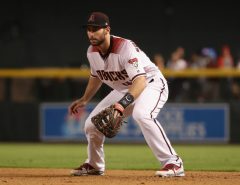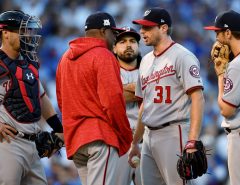Last summer, the Nationals made headlines at the deadline when they acquired Mark Melancon from the Pirates in exchange for reliever Felipe Rivero and righty Taylor Hearn. Later that season, as the rest of the league turned their attention to the playoff race, the two teams came together once again to make a trade that flew under the radar of the national media. Following the return of Joe Ross from the 60-Day DL, the Nationals DFA’d infielder Chris Bostick, and eight days later were able to find a trade partner for him in Pittsburgh. In return the Nationals received a switch hitting catching prospect out of Florida by the name of Taylor Gushue. This was a trade of two struggling prospects who needed a fresh start; and in Gushue the Nationals have found intriguing upside to that has begun to show itself early in 2017.
When Gushue joined the Nationals, he was coming off yet another disappointing season on both sides of the dish. In each of his first three seasons, Gushue saw his batting average and OBP decline, and despite his athleticism and above-average arm, the University of Florida product had only managed to throw out around 25% of attempted base stealers — a below average rate. While Gushue had always struggled to control the run game, he was regarded as a bat-first catcher out of the draft, and his poor offensive performance was badly hurting his stock. With limited statistical information and video available for minor league players (especially fringe prospects), Gushue’s offensive struggles were hard to pin down, but examining his peripherals provided some clues to solving the puzzle.
Gushue’s debut season was by far his best, with the switch hitting catcher imitating what many scouts thought he could do as a pro. Gushue hit for power, limited his strikeouts, and took a surprising number of walks. Over 233 plate appearances, Gushue batted .241/.336./.402 with five home runs, while putting up a wRC+ of 116, an ISO of .161, an OPS of .736, and a K% of just 15.9%; all excellent numbers for a catcher. But the following two years, things took a dive for the Boca Raton native.
In Low-A West Virginia, Gushue’s power dipped, as he hit five home runs again in 161 more at bats (putting up an ISO of only .111). Although he hit more long balls the following season in High-A Bradenton, Gushue was still unable to make consistent contact at the plate. His K% increased from 15.9% in 2014 to an even 20.0% in 2015 and 19.2% in 2016. Not only did Gushue start striking out more, but his BB% decreased from 11.6% to 6.4% over the two seasons combined. During these two years, Gushue only managed lines of .231/.288/.342 and .226/.282/.357, respectively.
Throughout this, the switch-hitting catcher maintained an ugly infield fly ball rate north of 22%, and although his batted ball rates remained stable in 2015, the 2016 season saw Gushue hit fewer line drives and more ground balls than ever. While I am far from a professional scout, these trends indicate to me that Gushue grew uncomfortable at the plate and was over-swinging in an attempt to generate power. Some metrics indicate Gushue was getting somewhat unlucky in 2016, as he had a below average BABIP (.260) and HR/FB% (7.6%), but even counting those the results were still far from ideal.
It was clear that Gushue was never able to get comfortable with the Pirates, and the backstop has taken full advantage of his fresh start with the Nationals. Through 18 games, Gushue has been lighting up opposing pitchers: He has nearly matched his career high with 7 home runs en route to a .303/.360/.367 line. If Gushue was looking for power in 2015 and 2016 he’s found it, making more contact thus far in the young season, and more importantly making that contact count. In a small sample size Gushue has put up an absurd 56% FB%, while reducing his GB% to 30% — a shift of 15 percentage points in both categories. A more patient approach at the plate has helped the former Gator, who has so far improved his walk rate over his previous two campaigns, getting closer to what he did in 2014. A 25% HR/FB%, a continuing lack of line drives and .295 BABIP suggest that Gushue is likely playing beyond his means at the moment, but the explosion of power, especially in the pitcher-friendly Carolina League, is very encouraging.
Despite his red hot start to 2017, Taylor Gushue still has a lot to work on before he’s touching any prospect rankings. His defense (read: ability to control the run game) has been lackluster again, and if Gushue is forced to move out from behind the plate his offensive profile becomes much less attractive. In addition to his troubling defense, Gushue’s peripherals are still imperfect, and suggest that his approach at the dish could still use a lot of work. Despite these flaws, Gushue possesses a unique offensive upside in a system full of defensively minded catching prospects.
We shouldn’t be completely writing off Gushue defensively either. He is still relatively young, and has the athleticism and arm strength that could help him become at least an average catcher, should he improve his footwork and pop time. Improving defensively is key to Gushue’s future as a prospect, but should he do so while building on his hot start to 2017, the Nationals may have a prospect on their hands that nobody saw coming.
Tags: Nationals, Nats, Taylor Gushue, Washington Nationals




Leave a Reply